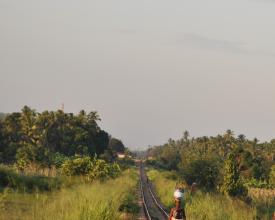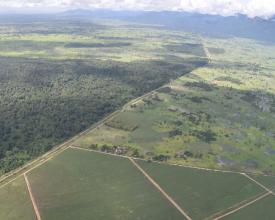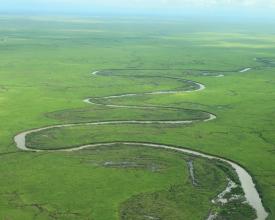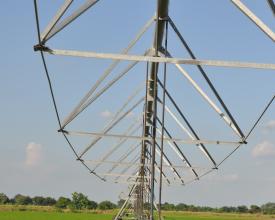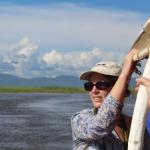
Engaging business to boost sustainability in African agriculture
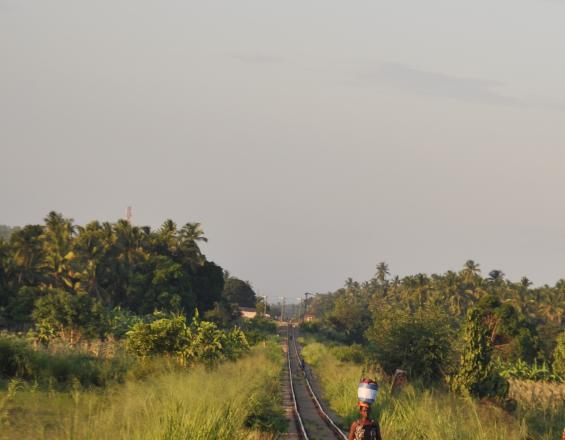
Growth corridors are regions where natural resource-based industries, such as agriculture and mining, are being developed to boost economic growth. SUSTAIN (Sustainability and Inclusion Strategy for Growth Corridors), an IUCN-led initiative, aims to shape the investment and design of these corridors so that they are environmentally and socially sustainable.
Located in a vast floodplain, Tanzania’s Kilombero district hosts wetlands, waterfalls and iconic wildlife species, such as elephant, hippo, antelope and lion. The mountain rainforests are a vital water source for the surrounding area and its economy. As part of SUSTAIN, the African Wildlife Foundation (AWF) is working with one of Tanzania’s biggest rice producers, valley farmers and mountain villages in Kilombero to increase agricultural productivity while conserving forests, water sources and wildlife at a coordinated landscape level. A pillar of the programme is a payment for ecosystems services (PES) scheme.
Context
Challenges addressed
- The population is growing rapidly. Over-exploitation of natural resources threatens natural ecosystems, such as the Kilombero Nature Reserve and the Ruipa wildlife corridor.
- People rely heavily on agriculture, mainly rice and cocoa. Economic dependence and lack of management knowledge lead to high losses during harvest and processing, resulting in lower incomes. Poor yields make land expansion necessary to increase production, which severs wildlife corridors, degrades forests, and encroaches on waterways. Where farming encroaches on wildlife corridors there is increased human-wildlife conflict.
- It takes time to align interests of farmers, pastoralists, business and government. Each group has its own perspective, time scale and way of working. Communication and creating space for dialogue are critical to form a shared vision.
- Applying global standards such as on ecosystem valuation can be complex and requires specialist knowledge not always easy to find in a timely manner.
Location
Process
Summary of the process
A need for continual monitoring and evaluation, adaptive management, transparency and accountability underlie and link these building blocks, which, together, create an inclusive landscape approach to sustainable agriculture.
Having access to new markets and higher revenues are strong motivations for farmers to conserve habitat and natural resources. Adequate documentation and regular checks are necessary to ensure that nature conservation is integrated into day-to-day farming practices.
Ultimately, trust and accountability are essential for the PES scheme to be effective. Once farmers prove they are improving conservation practices, they can be given training and other support in improving productivity using environmentally compatible measures.
AWF and partners are jointly learning and sharing their best practices from Kilombero across the Southern Agricultural Growth Corridor of Tanzania (SAGCOT) and beyond.
Building Blocks
Establishing inclusive governance
What institutions and policies are needed to foster inclusive green growth? This was the first and most critical question addressed by partners. Together, they assessed natural resources governance in Kilombero using a framework established by IUCN. They used a rights-based approach to improve social and economic inclusion in the district focussing on villages in lower Mngeta.
Village land use plans (VLUPs) are seen as key to addressing competing resource interests and resolving conflicts. However, many of the same factors making VLUPs important, such as high biodiversity value, scarce land, power imbalances, competing interests and accountability concerns, also make it challenging to ensure they are developed and implemented fairly. There appears to be very little landscape level or inter-village planning, including within the recently completed Kilombero District Land Use Framework.
Enabling factors
The company, KPL, showed an interest in sourcing more of its rice and milling services from local smallholders and was keen to encourage sustainable practices.
Creating water user associations and catchment management committees involving villages is helping them to own the governance of water use. One example is that local people have been trained to use a monitoring tool, Mini Stream Assessment Scoring System (miniSASS), to help gauge and report on the health of the Mchombe River.
Lesson learned
The SAGCOT initiative -- to catalyze responsible and inclusive agricultural investments in this southern corridor -- may exacerbate several challenges, including conflict over land if it does not explicitly address rights and equity issues.
Social and environmental assessments and experience with existing farmer schemes in Kilombero highlight substantial risks to the rights and interests of the most vulnerable, including women, pastoralists, and smallholders.
There is a clear need to strengthen capacity to improve governance and incorporate a rights-based approach through continual staff training within the partner organisations.
Land use mapping and scenario planning
Using satellite images of land use cover and change and other mapping tools, the team could begin to identify where protection or restoration are needed, and where sustainable agricultural expansion could take place. They also generated scenarios that considered different aspects such as wildlife needs, ecosystem services and agricultural productivity, to allow synergies and trade-offs to be identified and assessed.
Meetings were held with the various stakeholders that influence land use change, from district authorities and businesses to communities and conservationists, to try to ensure a participatory, landscape-level planning process.
Enabling factors
Technological advances such as satellite imagery and quality of mapping tools.
Creating the space for open discussion and a willingness among stakeholders to hear the perspectives of others.
Lesson learned
Involving all stakeholders is critical to negotiate and articulate objectives that are realistic to achieve and to form recommendations that minimise conflict between land uses.
There has to be a clear business case for investing in conservation and a willingness among companies to form new partnerships.
Designing and implementing an incentive scheme
A pillar of restoration efforts has been the design and implementation of a payment for ecosystems services (PES) scheme in the Mngeta catchment. Communities living upstream are helped to conserve water to secure enough downstream flow for the smallholders, who depend on rice farming. These farmers are linked to the Kilombero Plantations Company Ltd. (KPL) for access to technology to improve their productivity and access to markets.
Enabling factors
AWF brought together village land use committees, smallholder associations, Water User Associations, the Rufiji Basin Water Office, KPL and NGOs, such as the Tanzania Forest Conservation Group, to develop the PES scheme. Local government authorities are also involved and support the process. Involving such a diverse group of stakeholders is critical to developing a scheme that is realistic, sustainable and accountable.
KPL was keen to establish relationships with upstream forest communities to protect water sources for power and irrigation.
Lesson learned
The aim is to test this scheme and scale it up across key water basins in SAGCOT, but a potential risk is that upstream communities do not receive enough incentive to reduce deforestation or stop other activities that impact water flow and quality.
The indications are that this model is applicable to other value chains and there are partners willing to engage.
Impacts
- Restoration of degraded land and water sources, particularly in farm areas between Kilombero and Udzungwa Scarp Nature Forest Reserves.
- Formation of water user associations that empower communities to have control over local water resources management.
- Successful restoration of the Mchombe river through natural regeneration and tree planting along the river banks by community groups such as village natural resources committees.
- Increased awareness of and accountability for sound natural resources management.
- Improved awareness of farmer-wildlife conflict and fewer incidents through introducing measures such as beehive fencing and chilli pepper farming to deter elephants.
- Development of a model that is proving to be scalable and replicable within the region and beyond.
Beneficiaries
Farmers, forest communities, Kilombero Plantations Limited (KPL) and other businesses, wildlife.
Sustainable Development Goals
Story
The aim of SAGCOT is to engage 100,000 smallholder farmers in commercial agriculture to provide new jobs in farming, processing and transport and generate US $1.2 billion in revenues. The corridor runs through three landscapes important to conservation and ishome to sizeable elephant populations.
AWF is partnering with Kilombero Sugar Company, Tanzania’s largest sugar producer, to provide smallholders in their supply chain with climate-smart agriculture techniques and improved cane varieties in concert with agreements to land and water resource management practices that sustain ecological function and connectivity in the wider landscape. The company is scaling the climate-smart practices through their out-grower scheme, and considers SUSTAIN and AWF as strategic partners in planning current and future investments.
Another partnership has established a payment for ecosystem services scheme to support watershed conservation in the Mngeta sub-catchment. Kilombero Plantations Limited, which needs a healthy watershed for rice farming, pays four communities upstream from its plantations to help restore the degraded catchment.
These market-based partnerships have invested US$ 1 million in 40,286 hectares of land under sustainable management and target more than 33,000 beneficiaries. They aim to prove that conservation-friendly agriculture can extend beyond niche products for which consumers willingly pay higher prices. For major crops like rice and sugarcane, companies cannot pass along any additional costs for sustainable practices to their consumers. Yet, ensuring conservation success hinges on scaling up conservation-friendly agriculture to include commodity crop producers – the dominant decision makers over land and resource allocations.
Companies see the urgency in protecting ecosystems that underpin agricultural production and are collaborating with communities and technical experts to embed conservation into their products’ value chains – a crucial investment in their own long-term success.
These public-private partnerships that conserve land and improve livelihoods are providing a model for delivering inclusive, green growth throughout SAGCOT.

